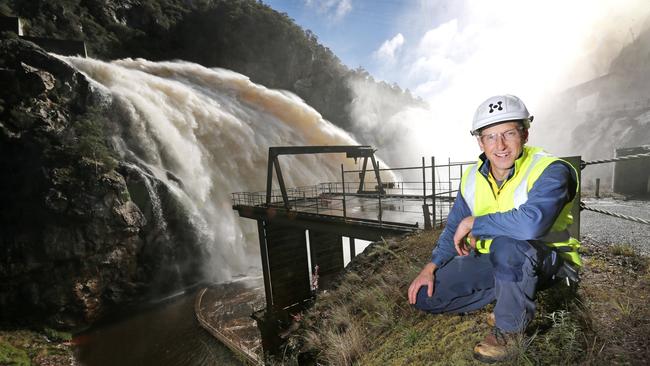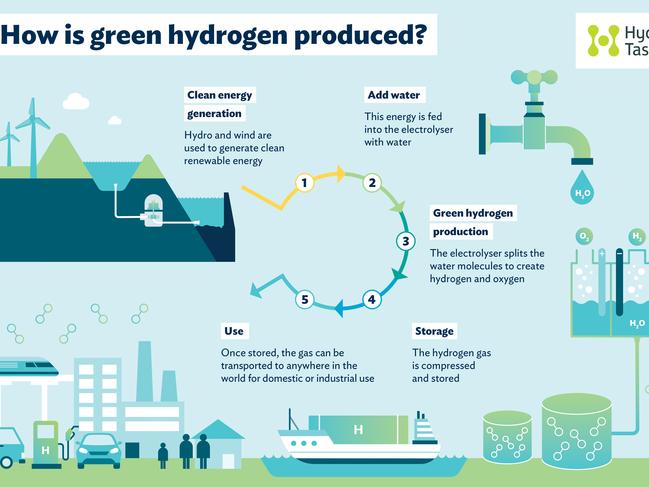Talking Point: Water = power adds up in Tassie
GUY BARNETT: Hydrogen energy could be the state’s next big export industry.

Opinion
Don't miss out on the headlines from Opinion. Followed categories will be added to My News.
OVER the past 100 years, Tasmania has built its economy on renewable energy, which has provided cost competitive, reliable clean power.
I addressed the Global Hydrogen Energy Summit in Victoria recently to outline Tasmania’s natural advantages and existing renewable resources that perfectly positions us to benefit from the emerging global hydrogen industry.
Tasmania is Australia’s leading renewable energy state, and is on track to be self-sufficient in renewables by 2022, making it the first state in Australia with 100 per cent renewable power generation.
Tasmania already generates low cost, reliable, clean energy for the nation, producing nearly a quarter of Australia’s renewable energy, while consuming just 2 per cent of the nation’s energy.

We are developing the Tasmanian Renewable Energy Plan which sets out objectives and actions to transform Tasmania into a national and global renewable energy hub.
Emerging demand for renewable hydrogen presents a chance for Tasmania to develop a hydrogen industry powered by renewable energy, creating jobs and positioning us as a global leader in renewable energy supply.
The Tasmanian Government is working to ensure we are well placed to capitalise on this new global industry, in recognition that Tasmania’s strengths make it an ideal location for renewable hydrogen projects.
I released the Tasmanian draft Renewable Hydrogen Action Plan in November last year, which articulates the Government’s vision and a suite of actions to use Tasmania’s existing and expandable renewable energy, and water resources, to become a leader in large-scale renewable hydrogen production.
We are working hard to finalise our plan, including reviewing the many submissions received from stakeholders, and I look forward to releasing the final plan in March.
Analysis indicates the cost of renewable hydrogen production in Tasmania could be 10 to 15 per cent lower than from other Australian power grids, and 20 to 30 per cent lower than from dedicated off-grid variable renewables.
Tasmania has high quality industrial precincts, including the Bell Bay advanced manufacturing zone, with access to deepwater ports, strong transmission infrastructure, significant water availability and road and rail infrastructure, a highly skilled and innovative workforce, and world-class educational and research institutions including the Blue Economy Co-operative Research Centre.
Importantly, the plan establishes a series of actions and goals to kickstart this industry in Tasmania.
By 2022 our goal is to have commenced production and use of renewable hydrogen in Tasmania.
In fact, Government’s vision is for a Tasmanian renewable hydrogen industry over the next decade that could support a 1000 megawatt production plant creating over 1200 regional jobs and supporting a further 2000 megawatts of renewable energy investment.
Tasmania’s Battery of the Nation initiative and additional Bass Strait interconnection (through Project Marinus) are projected to play a vital role in ensuring a reliable and affordable national electricity market as it transitions away from one dominated by coal generation to a more diverse supply mix with increasing levels of variable renewable generation.
The Battery of the Nation initiative has identified up to 3400 megawatts of pumped storage capacity that would more than double Tasmania’s existing energy capacity (2300 megawatts).
For Tasmania alone, Marinus and the induced renewable energy investments will inject up to $7.1 billion into the economy. This includes:
FROM the development, construction and operation of the Marinus project — $1.4 billion direct and indirect economic injection and up to 1400 direct and indirect jobs;
FROM the induced renewable energy developments up to $5.7 billion injection into the economy and up to 2350 direct and indirect jobs.
The development of a large-scale renewable hydrogen industry is complementary to Battery of the Nation and Project Marinus, reflecting the strength of Tasmania’s existing and expandable renewable energy resources.
With our renewable energy, Tasmania is an ideal location to produce cost-competitive renewable hydrogen on a large-scale to meet this emerging export and domestic demand and become a global leader in renewable energy.
Lyons Liberal MHA Guy Barnett is Tasmanian Energy Minister.


